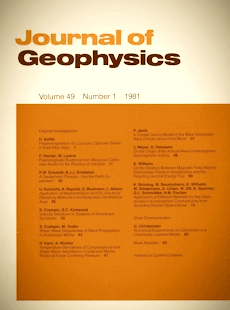A geotectonic paradox: Has the Earth expanded?
Article Sidebar

Vols. 1-18 (1924-1944), ISSN 0044-2801
Main Article Content
Abstract
From the recognition of common apparent polar-wander (CAPW) paths for Africa, Australia, Greenland, and North America in the early Proterozoic, we have deduced that these continents today occupy approximately the same relative locations on the globe as they did in the early Proterozoic. However, there is abundant geochemical, geological, geochronological and tectonic evidence for landmasses having been much less dispersed in the Precambrian than they are now. It is shown in this paper that an Earth of about half the present radius accomodates the present continents in such a manner that this paradox can be satisfactorily resolved, and we propose that between about 1,600 Myr and 1,000 Myr ago, the Earth expanded to approximately its present dimensions. A change from Proterozoic to Phanerozoic tectonic styles is supported.
 ARK: https://n2t.net/ark:/88439/y034403
ARK: https://n2t.net/ark:/88439/y034403
Permalink: https://geophysicsjournal.com/article/34
Article Details
References
Briden, J.C.: Applicability of plate tectonics to pre-Mesozoic time. Nature 244, 400-405, 1973
Burke, K., Dewey, J.F., Kidd, W.S.F.: Precambrian palaeomagnetic results compatible with contemporary operation of the Wilson Cycle. Tectonophysics 33, 287-299, 1976
Carey, S.W .. The expanding earth. Amsterdam: Elsevier 1976
Cavanaugh, M.D., Seyfert, C.K.: Apparent polar wander paths and the joining of the Superior and Slave provinces during Proterozoic time. Geology 5, 207-211, 1977
Clifford, T.M.: Radiometric dating and the pre-Silurian geology of Africa. In: Radiometric dating for geologists, E.I. Hamilton and R.M. Farquhar, eds.: pp. 299-416. New York: Interscience 1968
Cox, A., Doell, A.R.: Palaeomagnetic evidence relevant to a change in the earth's radius. Nature 189, 45-47, 1961
Creer, K.M.: An expanding earth? Nature 205, 539-544, 1965
Creer, K.M., Irving, E., Runcorn, S.K.: Geophysical interpretation of palaeomagnetic directions from Greater Britain. Philos. Trans. R. Soc. London, Ser. A:250, 144-156, 1957
Embleton, B.J.J., Schmidt, P.W. ·Recognition of common Precambrian polar wandering: a conflict with plate tectonics. Nature 282, 705-707, 1979
Engel, A.E.J., Keirn, D.L.: Pre-Permian global tectonics: A tectonic test. Geol. Soc. Am. Bull. 83, 2325-2340, 1972
Fisher, R.A.: Dispersion on a sphere. Proc. R. Soc. London, Ser. A :217. 295-305, 1953
Glikson, A.Y.: Archaen to early Proterozoic shield elements: relevance of plate tectonics. Geol. Assoc. Can., Spec. Pap. 14, 489-516, 1976
Glikson, A.Y.: The missing Precambrian crust. Geology 7, 449-454, 1979
Graham, K.W.T., Hales, A.L.: Palaeomagnetic measurements on Karroo Dolerites. Philos. Mag. [Suppl., Adv. Phys.] 6, 149-161, 1957
Hargraves, R.B.: Precambrian geologic history. Science 193, 363-371, 1976
Hilten, D. Van: Global expansion and palaeomagnetic data. Tectonophysics 5, 191-210, 1968
Hurley, R.M., Rand, J.R.: Pre-drift continental nuclei. Science 164. 1229-1242, 1969
Irving, E. : Drift of the major continental blocks since the Devonian. Nature 270, 304-309, 1977
Irving, E.: Paleopoles and paleolatitudes of North America and speculations about displaced terrains. Can. J. Earth Sci. 16, 669-694, 1979
Irving, E., Green R.: Polar wandering relative to Australia. Geophys. J.R. Astron. Soc. 1, 64-72, 1958
Irving, E., McGlynn, J.C.: Proterozoic magnetostratigraphy and the tectonic evolution of the Laurentia. Philos. Trans. R. Soc. London, Ser. A: 280, 243-265, 1976
Irving, E., McGlynn, J.G.: Palaeomagnetism in the Coronation Geosyncline and arrangement of the continents in the middle Proterozoic. Geophys. J.R. Astron. Soc. 58, 309-336, 1979
Irving, E., Park, J.K.: Hairpins and superintervals. Can. J. Earth Sci. 9, 1318-1324, 1972
McElhinny, M.W., Embleton, B.J.J.: Precambrian and early Palaeozoic palaeomagnetism in Australia. Philos. Trans. R. Soc. London, Ser. A:280, 417-431, 1976
McElhinny, M.W., McWilliams, M.O.: Precambrian geodynamics ~ a palaeomagnetic view. Tectonophysics 40, 137-159, 1977
McElhinny, M.W., Taylor, S.R., Stevenson, D.J.: Limits to the expansion of Earth, Moon, Mars and Mercury and to changes in the gravitational constant. Nature 271, 316-321, 1978
Moor bath, S.: The oldest rocks and the growth of continents. Sci. Am. 236, 92-104, 1977
Morel, P., Irving, E.: Tentative palaeo-continental maps for the early Phanerozoic and Proterozoic. J. Geol. 86, 535-561, 1978
Piper, J.D.A.: Proterozoic crustal distribution, mobile belts, and apparent polar movements. Nature 251, 381-384, 1974
Piper, J.D.A.: Palaeomagnetic evidence for a Proterozoic supercontinent. Philos. Trans. R. Soc. London, Ser. A:280, 469-490, 1976
Piper, J.D.A., Briden, J.C., Lomax, K.: Precambrian Africa and South America as a single continent. Nature 245, 244-248, 1973
Piper, J.D.A., Stearn, J.E.F.: Palaeomagnetism of Ketilidian meta morphic rocks of S.W. Greenland, 1850-1600 m.y. apparent polar movements. Phys. Earth Planet. Inter. 13, 143-156, 1976
Roy, J.L., Lapointe, P.L.: The palaeomagnetism of Huronian red beds and Nipissing diabase; Post-Huronian Igneous Events and apparent polar path for the interval -2,300 to -1,500 Ma for Laurentia.
Can. J. Earth Sci. 13, 749-773, 1976
Roy, J.L., Morris, W.A., Lapointe, P.L., Irving, E., Park, J.K., Schmidt, P.W.: Apparent polar wander paths and the joining of the Superior and Slave provinces during early Proterozoic times: Comment. Geology 6, 132-133, 1978
Runcorn, S.K.: Palaeomagnetic comparisons between Europe and North America. Proc. Geol. Assoc. Can. 8, 77-85, 1956
Schmidt, P.W., Clark, D.A.; The response of palaeomagnetic data to Earth expansion. Geophys. J.R. Astron. Soc. 61, 95-100, 1980
Scotese, C.R., Bambach, R.K., Barton, C., Vander Voo, R., Ziegler, A.M.: Paleozoic base maps. J. Geol. 87, 217-277, 1979
Sears, J.W., Price, R.A.: The Siberian connection: a case for Precambrian separation of the North American and Siberian craton. Geology 6, 267-270, 1978
Shackleton, R.M.: Displacement within continents. In: Time and place in orogeny. Geol. Soc. London, Spec. Pub!. 3, 1-7, 1969
Smith, A. G., Briden, J.C., Drewry, G.E.: Phanerozoic world maps. In: Organisms and continents through time. Spec. Pap. Palaeontol. 12, 1-42, 1973
Smith, A. G., Hallam, A.: The fit of the southern continents. Nature 225, 139-144, 1970
Sutton, J., Watson, J.V.: Tectonic evolution of continents in early Proterozoic times. Nature 247, 433-435, 1974
Ward, M.A .. On detecting changes in the Earth's radius. Geophys. J.R. Astron. Soc. 8, 217-225, 1963
Ward, M.A.: Comments on detecting changes in the Earth's radius. Geophys. J.R. Astron. Soc. 10, 445-447, 1966











